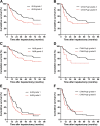Ability of the ALBI grade to predict posthepatectomy liver failure and long-term survival after liver resection for different BCLC stages of HCC
- PMID: 30326907
- PMCID: PMC6192221
- DOI: 10.1186/s12957-018-1500-9
Ability of the ALBI grade to predict posthepatectomy liver failure and long-term survival after liver resection for different BCLC stages of HCC
Abstract
Background: Underlying liver function is a major concern when applying surgical resection for hepatocellular carcinoma (HCC). We aimed to explore the capability of the albumin-bilirubin (ALBI) grade to predict post-hepatectomy liver failure (PHLF) and long-term survival after hepatectomy for HCC patients with different Barcelona Clinic Liver Cancer (BCLC) stages.
Methods: Between January 2010 and December 2014, 338 HCC patients who were treated with liver resection were enrolled. The predictive accuracy of ALBI grade system for PHLF and long-term survival across different BCLC stages was examined.
Results: A total of 26 (7.7%) patients developed PHLF. Patients were divided into BCLC 0/A and BCLC B/C categories. ALBI score was found to be a strong independent predictor of PHLF across different BCLC stages by multivariate analysis. In terms of overall survival (OS), it exhibited high discriminative power in the total cohort and in BCLC 0/A subgroup. However, differences in OS between ALBI grade 1 and 2 patients in BCLC B/C subgroup were not significant (P = 0.222).
Conclusion: The ALBI grade showed good predictive ability for PHLF in HCC patients across different BCLC stages. However, the ALBI grade was only a significant predictor of OS in BCLC stage 0/A patients and failed to predict OS in BCLC stage B/C patients.
Keywords: Albumin-bilirubin score; BCLC classification; Child-Pugh grade; Hepatocellular carcinoma; Overall survival; Post-hepatectomy liver failure.
Conflict of interest statement
Ethics approval and consent to participate
Written permission was given up in the current research. This research was authorized by the ethics committee of the Central South University.
Consent for publication
Not applicable.
Competing interests
The authors declare that they have no competing interests.
Publisher’s Note
Springer Nature remains neutral with regard to jurisdictional claims in published maps and institutional affiliations.
Figures



References
MeSH terms
Substances
LinkOut - more resources
Full Text Sources
Medical

